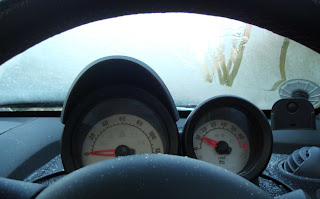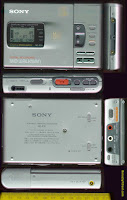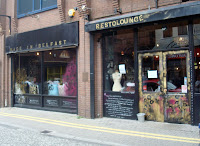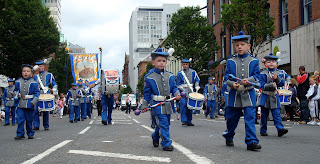
The Belfast County parade was long and colourful, albeit monotonously flute and drum. But the Belfast field was something else.
The ranks of Orangemen, led by their hired-in bands, have to march to somewhere. And that somewhere is known as “the field”. Belfast’s field has moved over the years: from Finaghy to Edenderry, briefly to Ormeau Park one eventful year, and most recently settled in the Council’s park at Barnett Demesne (Malone House).
As part of our tour, after grabbing a sandwich in Tesco (which was thankfully open for the first time on the Twelfth) we drove up towards the House of Sport roundabout and abandoned our cars down a leafy side street.
Sometime after 2pm the last of the parade snakes into the grounds. At 2.30pm, the County officers – sitting on their platform (a big lorry’s trailer) – hold their religious ceremony. After all, the Orange Order strongly asserts its Christian roots and foundation.
“Due to a printing error, the words of the two hymns aren’t printed in the order of service this year. But they should be well known.”

An inauspicious start! As they began, I counted less than twenty Orangemen standing listening to the service. (They’re quite easy to spot with their suits and sashes.) There were more of us in our tour group listening – and nearly more media –than parading Orangemen.
While the platform party had hymn books and led the singing unaccompanied, no one else joined in Blessed Assurance (just verse one). You’d think with all those musicians present, one of the bands could have been asked to accompany the hymns? (Is the lack of music an act of respect to Reformed Presbyterians?)
Twenty minutes later, the number of Orangemen assembled around the platform had swollen to around sixty. But still a tiny minority of the hundreds and thousands of hot-footed brethren who had marched to the field.

The sermon was unintelligible. Partly a factor of the lousy PA (a couple of old style 100 volt horns on either side of the trailer) that meant it was in no way deafening, and in no way easy to hear above the chatting picnickers. And partly the tone and language that was being used. It didn’t really engage the crowd.
Sadly, it reminded me of a bad Sunday School lesson. One where the teacher has completely lost control of the children. But soldiers on, talking over the noise and misbehaviour.

They had an offering for Orange Charities, collecting coins from those standing around the platform, but not venturing back into the crowds in the rest of the field. And then it was time to close up with the first and last verses of O Lord Our Help In Ages Past.
They passed (announced really) two religious resolutions - Faith and Loyalty - during the service, and then a third political one (State) as part of the public meeting they kicked off at 3pm.
In this 90th anniversary year of the signing of the Armistice in 1918, we reflect on those many members of our Institution and the wider community who lost their lives in the First World War. Their loss has a special resonance for the people of Ulster.
We bring to mind all those members of Her Majesty's Forces who are currently serving in areas of conflict across the world, particularly in Afghanistan and Iraq. We recall today those many innocent victims of violence in our own land and call for just recognition of the suffering which they have endured. In a changing world, we share the distress of those millions of people who have suffered through the result of natural disaster in Burma and China. We commend the efforts of relief agencies and all those working to assist in those and other distressed areas of the world.
The republican movement has orchestrated a campaign of attacks on Orange Halls since 1989 which is still ongoing. We condemn all attacks on our Orange Halls and sympathise with those brethren, north and south, whose property has been damaged. As an Institution we have withstood much and will continue to stand firm for our beliefs into the future. We seek nothing more than civil and religious liberty for all and respect for our traditions and witness.
We continue to watch with interest the political situation in Northern Ireland and have reservations about the presence of those in government whom we would not see as democrats in the accepted sense. The ongoing dogmatic approach of some within the government causes us concern as we look to a better future for all citizens of Northern Ireland.
A resolution taking in World War One, modern conflict as well as those in need after natural disaster. No mention of Zimbabwe. And a holding statement on the folks on the hill at Stormont.
But the real business of the day seemed to be taking place in the queues for the burger vans, in the lodges’ marquees dotted around the field, in the bouncy castles full of kids and in front of the stalls (selling all kinds of tat, mostly coloured red, white and blue).


Portaloos had been provided, but the bushes seemed to be bustling with bursting bladders. Aerosols of hair spray were selling well, along with light-up swords. Feel the force!
The was little interest in the service, and not that much interest in the “political” resolution that followed it. Which I think showed a huge gap between the expectations of the Orange leadership and those who had travelled to their field. While the intention was there, it certainly painted a different picture than the blurb on the Grand Orange Lodge’s website:
Orange Institution is a Christian organisation.
As Orangemen our trust is in God and our faith and dependence is in Jesus Christ, the Saviour and Lord of mankind. Our purpose is to maintain the Christian faith by word and deed; to propagate and defend that faith which we have received from the Church of the New Testament through the faithfulness of the Protestant Reformers. It is Christ-centred, Bible-based, Church-grounded. By it we are moulded in character and conduct.
The Orange Institution is set for the defence of Protestantism. This is true to the intention of Orangemen who are committed to the Christian faith with its Reformation emphasis on a personal relationship with Jesus Christ as the Lord and Saviour of mankind. There are also the Protestant beliefs in freedom of conscience; the priesthood of all believers and the primary place and purpose of the Holy Bible in Christian faith and conduct.
We proclaim "Civil and religious liberty for all : special privileges for none". We do not deny to others their civil and religious liberties; we expect the same tolerance from them. We shall be strong for truth, for peace, for the making of a good, fair and just society to which we shall contribute liberally as good citizens.
Overall, a visit to the Twelfth parade and field is very non-threatening and I'd recommend anyone with an interest (or an absence of understanding) to go along and see what's happening. Though not all Orangemen want the event to become cultural tourism ...












![alan in [Belfast b logo]](https://blogger.googleusercontent.com/img/b/R29vZ2xl/AVvXsEjol6tlXAxjlaTzdDB8R7Xml0mly0mFbj-v-RyQON4xCkMHHOZ4tho5QyHiuBDOZ3MuBQAfAbsp1NpAOQ2B_qOvtPanukLe6rOoe8HIPcVvug-QldzMWIeCIvcuU9E9iOk4nF-C/s320/AiB+Belfast+logo.jpg)




































